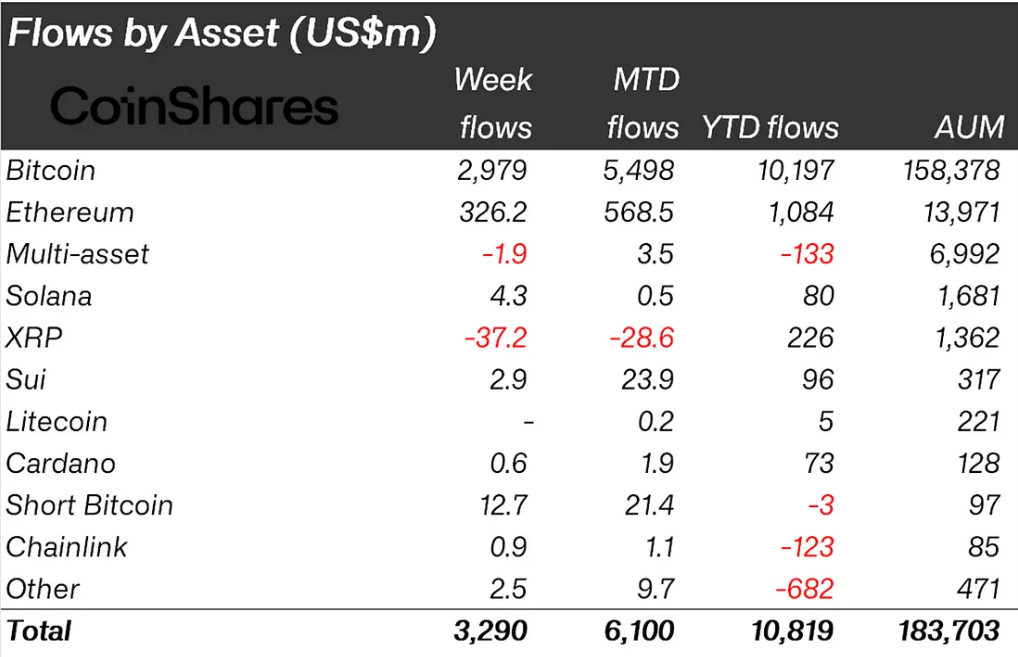-
Recent data reveals a dramatic surge in crypto inflows, reflecting growing investor confidence amid increasing economic uncertainty in the US.
-
Bitcoin’s domination in capital inflows highlights its resilience, while Ethereum capitalizes on the upcoming Pectra upgrade.
-
“Digital assets are increasingly viewed as a hedge against traditional market volatility,” asserts analyst James Butterfill from CoinShares.
Crypto inflows reached a record $3.3 billion last week, driven by economic fears, signaling a growing shift towards digital assets.
Record Crypto Inflows Amid Economic Concerns
According to a detailed report by CoinShares, last week’s stunning inflows reached $3.29 billion, predominantly from the US, reflecting considerable domestic economic anxiety. As traditional markets fluctuate, investors show an increasing preference for digital assets to safeguard their capital.
Further contributions originated from countries such as Germany ($41.5 million), Hong Kong ($33.3 million), and Australia ($10.9 million). In contrast, Switzerland experienced substantial outflows of $16.6 million, likely fueled by profit-taking following Bitcoin’s recent all-time high performance.
James Butterfill from CoinShares emphasizes Bitcoin’s position as the key player, with $2.9 billion in inflows, sharply defining its market leadership. This figure represents over 25% of the total digital asset inflows for the year.

Source: CoinShares
Ethereum also gained significant traction, attracting $326 million in inflows, marking its highest performance in 15 weeks. The anticipation surrounding Ethereum’s Pectra upgrade significantly fuels this sentiment, leading to five consecutive weeks of positive inflows.
Interestingly, short-Bitcoin products welcomed $12.7 million in inflows, the highest recorded since December 2024, suggesting a cautious investor sentiment in anticipation of potential market volatility.
This surge in inflows aligns closely with rising investor concerns regarding the stability of the US economy, driven by Moody’s downgrade warnings and climbing treasury yields.
“Growing concerns over the US economy, as highlighted by the recent Moody’s downgrade, have prompted many investors to seek diversification through digital assets,” noted the CoinShares report.
The latest week’s inflows mark a substantial increase from the preceding two weeks, where COINOTAG reported modest inflows of $785 million and $882 million. This significant shift underscores an accelerating pivot towards cryptocurrencies as macroeconomic risks intensify.
Moody’s outlook on the US credit rating remains negative, which has stoked fears surrounding the government’s fiscal situation. Last week’s cautionary statements about the deteriorating fiscal profile of the US reinforced existing concerns.
“No other major developed economy faces the pressure to grow its GDP by nearly 5% merely to service its debt,” commented macro investor Otavio Costa, encapsulating the bearish narrative surrounding the US dollar.
The implications are stark: worries about US debt sustainability mounted alongside stubbornly high treasury yields, which linger at multi-decade highs. This financial climate fosters an environment where digital assets such as Bitcoin are increasingly regarded as effective hedges against sovereign credit risks.
The overarching trend suggests that as macroeconomic instability persists, cryptocurrencies are regaining their status as alternative portfolio diversifiers.
This is particularly evident in the impressive total digital asset inflows of $10.5 billion over the past six weeks, an extraordinary display of recurring institutional interest.
Given the ongoing pressures on US fiscal and monetary policies, capital may continue migrating from traditional risk assets to decentralized alternatives, providing a fertile ground for crypto investments in the near future.
Conclusion
In summary, the recent spike in crypto inflows illustrates a significant shift in investor strategy amidst growing economic uncertainty. With Bitcoin and Ethereum leading the way, it is clear that digital assets are being increasingly viewed as vital components of modern investment portfolios. As economic pressures mount, this trend may very well continue, shaping the future landscape of financial investments.






